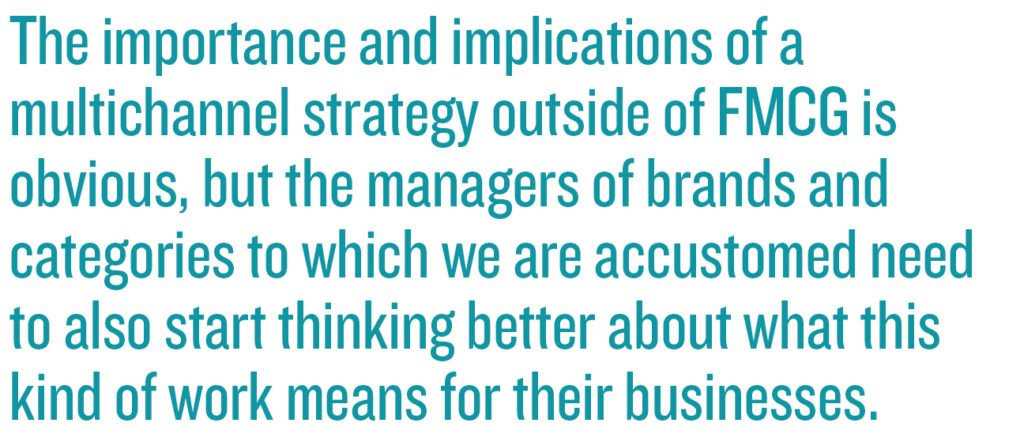
We’ve recently connected with Sandy Jap, a Sarah Beth Brown Endowed Professor in Marketing at Emory University, to expand our thinking about transferred demand. I don’t need to ramble any further about the importance of focusing on the concept of incrementality versus transferred demand. However, Sandy is on the forefront of an equally important yet slightly different concept. In the late 1970s, John D.C. Little and the team at Management Decision Systems, Inc. (MDS) —who eventually provided me several of my mentors at IRi after IRI acquired MDS—defined the “data cube”as marketing measures residing in the dimensions of products, geography, and time periods. The overwhelming majority of work that Middlegame has produced focuses on the product dimension related to incrementality versus transferred demand. What about the other two?
Sandy and her colleague, Tim Gilbride presented the most downloaded report of 2017 at the Marketing Science Institute (MSI), “Multichannel Sales Attribution and Media Optimization” that had a simple, but incredibly important premise. Brands are forced to manage multiple channels and routes-to-market in order to reach their end customers. Just like brands with many SKUs need to think about incrementality versus transferred demand, organizations deploying a multichannel strategy must understand the contribution of each channel to the overall brand while optimizing the various roles of the channels for maximum overall performance. Basically, they defined an approach similar to Competitive Interaction Analysis (CIA)®for the geographies dimension.
Their framework is easily adapted to what we have been doing at Middlegame. It allows decision-makers to provide targets for the optimal mix of marketing investments across assortment, pricing, merchandising, and media investment in order to maximize incrementality across a multichannel system. As expected, the demand and investment data are readily available. When combined with internal marketing channel cost data, the full financial picture is complete. By understanding the potential profitability of each unique channel, as well as the whole routes-to-market system, marketers can offer a far better explanation of their proposed strategies to stakeholders who are engaged in these plans and the subsequent allocation of budgets.

The importance and implications of a multichannel strategy outside of FMCG is obvious, but the managers of brands and categories to which we are accustomed need to also start thinking better about what this kind of work means for their businesses. A recent McKinsey article, “Global Customer and Channel Management,” highlights this with specific emphasis on emerging markets. This paper recommends prioritizing pockets of growth within both traditional and modern retail channels that are based upon an understanding of both forecasted growth trajectory and the cost-to-serve levels in each channel. A channel-driven strategy for assortment, pricing, and merchandising from a portfolio perspective can then be designed for the sales team. Basically, McKinsey defines everything that “Multichannel Sales Attribution and Media Optimization” does without the modelling detail.
We have started working with Sandy and Tim to commercialize their modelling framework that is aligned with the insights and subsequent ease of cost associated with the CIA® platform. The focus is more on merchandising and media than assortment and pricing, but the principals of incrementality and transferred demand still remain. I adore the MSI paper, but suggest that you dig further into the outstanding research that both Sandy and Tim have done. Sandy wrote a book called Partnering with the Frenemy that is a slightly different topic but an excellent read nonetheless. It was selected as a finalist for the 2018 Leonard Berry Marketing Book Award. Tim is an expert on Bayesian applications in marketing as well as choice models. You can imagine how quickly that resonates with us at Middlegame. His background in both the academic and practitioner side offers a lot of value to somebody like me as well. The recent paper “Metric Effectiveness and Use in Marketing-Mix Decisions” that Tim co-authored is especially valuable. His discussion about awareness and willingness to recommend versus target volume, net present value, and net profit is well worth diving into.
Middlegame is the only ROMI consultancy of its kind that offers a holistic view of the implications of resource allocation and investment in the marketplace. Our approach to scenario-planning differs from other marketing analytics providers by addressing the anticipated outcome for every SKU (your portfolio and your competitors’) in every channel. Similar to the pieces in chess, each stakeholder can now evaluate the trade-offs of potential choices and collectively apply them to create win-win results.
